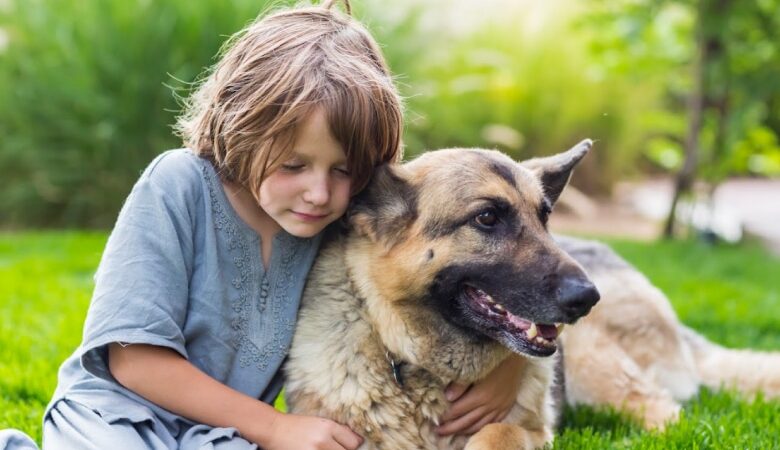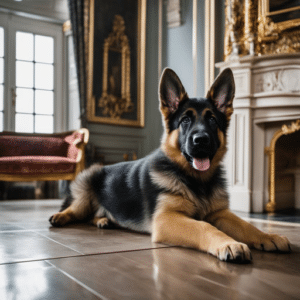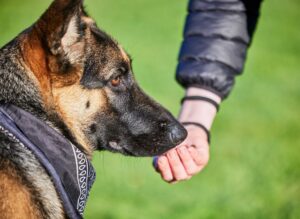






“A dog is the only thing on earth that loves you more than he loves himself.” – Josh Billings
This sentiment resonates deeply with protection dogs, whose training instills a relentless commitment to their family’s safety. But, integrating such a specialized dog into your home is a choice that needs to be well thought out and planned for.
And while you’ve had time to contemplate this choice, you must understand that your new companion faces an abrupt transition.
Suddenly thrown into an unfamiliar environment with new faces, personalities, and expectations, the dog will need time—typically a few months—to build trust, acclimate, and understand its place within your family.
Now this article will walk you through the essential steps to introduce a protection dog to your family, ensuring that everyone, including the new furry member, feels comfortable and secure.

And while you’re at it, stock up on high-quality dog food, toys that can withstand a bit of tough love, and any necessary grooming tools.
Like with any new pet, dog-proof your home by removing potentially hazardous items or securing toxic plants, chemicals, and small objects that could be swallowed.
You ought to remember that most protection dogs are often large and bursting with energy. That priceless vase on the wobbly shelf? Yeah, you might want to find a new, less precarious space.
Tip: You may want to consult with the trainer about specific dietary requirements or preferred equipment (your new guardian might have a more sophisticated palate than you’d expect!)
Get the whole family involved in learning about the breed, understanding their behavior, and discussing the responsibilities involved. This isn’t just another pet – it’s a highly trained professional with a serious job.
Everyone – from Grandpa Joe to little Susie – needs to be on the same page with commands and routines. If Mom says “sit” and Dad says “park it,” the dog might get confused. This means understanding the importance of consistency because those commands are not just suggestions but a code between you and your protection dog.
Make it a family project to learn the dog’s commands and routines together. Perhaps play some role-playing games. Who wants to be the dog? Who wants to practice giving commands?
It’s also crucial for your family members, especially the little ones, to know how to interact with the dog respectfully and safely.
Set some ground rules. No tugging on tails or surprise cuddle attacks, no matter how tempting. How about creating a colorful chart of dos and don’ts?
Timing is everything. Choose a period when you can dedicate several days to helping your new family member settle in.
Maybe that three-day weekend coming up? Or those vacation days you’ve been saving? Trust me, you’ll want to be there every step of the way for this transition.
The first meeting between your family and the protection dog should be controlled and calm. You’ll want a place where everyone feels relaxed, not territorial. So go for a neutral location (maybe that quiet park down the street.)
Now, here’s the golden rule: let your dog set the pace. No rushing in for bear hugs or head pats.
Allow the dog to approach each family member when they’re ready, avoiding sudden movements or loud noises that could startle him/her.
Pay close attention to the dog’s body language during the introduction. Signs of stress or anxiety, such as cowering, growling, or excessive barking, indicate the need for a slower approach.
Conversely, a relaxed posture, wagging tail, and curiosity are positive signs of a smooth introduction.
Remember, your dog is reading you too, so keep those positive vibes flowing.
Once the initial meet-and-greet goes smoothly, gradually introduce the dog to your home environment. Start with short, leashed visits to different areas of your home. Gradually increase the duration of these visits, always monitoring the dog’s comfort level and behavior.
When it’s time for the big move-in day, keep things calm and quiet. Let your new family members explore at their own pace. No welcome-home parties just yet!
Protection dogs aren’t just intelligent; they thrive on structure. Set up consistent schedules for meals, walks, and training sessions. Maybe a brisk morning walk followed by a cool down and then breakfast at 7.30 AM sharp, Lunch at noon, afternoon training at 3 PM, evening stroll at 6 PM, and dinner at 7 PM.
Your dog will start anticipating these events and this helps them feel secure and adjust to their new world.

Also, consider enrolling in professional obedience classes – it’s a great bonding experience for the whole family.
Decide which areas of your home are dog-friendly zones and which are off-limits. You can use baby gates or barriers if necessary to create a structured environment.
Stick to these rules consistently – your dog will appreciate knowing exactly where they stand (or sit, or lie down) in your home.
Building a strong bond with your family protection dog isn’t about grand gestures – it’s the little things that count.
Daily walks, games of fetch, or even just quiet time together can work wonders.
These interactions aren’t just fun; they provide the mental and physical stimulation your highly trained companion needs.
When it comes to encouragement, think of less drill sergeant and more cheerleader. Treats, praise, and affection are your MVPs here.
Positive reinforcement isn’t just effective; it builds trust and strengthens your bond.
Your dog will start to see you less as “the boss” and more as “my favorite human.”
Your protection dog is trained to be, well, protective. But you don’t want them going all bouncer-at-a-nightclub on every stranger they meet. That’s where socialization comes in.
Start exposing them to different environments, people, pets, and other animals. Take them to the park, invite friends over, or even just sit outside a cafe and people-watch together.
The goal is to build their confidence and teach them the difference between a real threat and just another day in the neighborhood.
Ensure you keep a close eye on your dog’s behavior and overall well-being. Watch for any signs of stress, anxiety, or aggression. Don’t hesitate to call in the pros – regular chats with a trainer or vet can provide invaluable insights.
Now, the transition process may require adjustments. Be flexible and willing to adapt your approach based on the dog’s needs and responses.
Last but not least, prioritize your protection dog’s health. Regular vet visits, a balanced diet, and plenty of exercise are non-negotiable.
I’ll be honest: introducing a protection dog to your family and integrating them takes patience, dedication, and a willingness to adapt.
Don’t forget that your protection dog is also adjusting to a new life. But with the right approach, you’ll create a secure and loving environment that builds a powerful partnership.
This approach includes creating a safe space, educating your family, establishing routines, building strong bonds, and paying close attention to your dog’s needs.
The best part? You don’t have to do it alone.
While most trainers offer onboarding programs, Vanguard’s Concierge Onboarding goes a step further. We believe your journey with your protection dog begins well before they arrive at your home
That’s why our exclusive service provides you with the personalized support, training sessions, and resources you need to ensure a smooth transition for your entire family. Consider us your personal guide to protection dog parenthood!
Ready to take the next step? Contact us today to learn more about our onboarding program and how we can help you welcome your protection dog into your home.
Schedule a meeting with our experts for a free consultation.